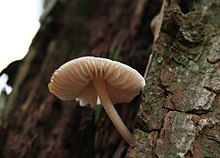Osmotrophy
This article includes a list of general references, but it lacks sufficient corresponding inline citations. (April 2013) |
Osmotrophy is a feeding mechanism involving the movement of dissolved organic compounds by osmosis. Organisms that use osmotrophy are called osmotrophs. Osmotrophy is used by diverse groups of organisms.[1] Organisms that use osmotrophy include microorganisms like bacteria, many species of protists and most fungi. Invertebrate animal groups like molluscs, sponges, corals, brachiopods and echinoderms may use osmotrophic feeding as a supplemental food source.
Process
[edit]Osmotrophy, as a means of gathering nutrients in microscopic organisms, relies on the cellular surface area to ensure that proper diffusion of nutrients occurs in the cell.[2] In other words, an osmotroph is an organism that has their "stomach" outside of their body. Some osmotrophs may have an internal digestive system, while still using osmosis as a way to gain supplemental nutrients. With bigger organisms, the surface-area-per-volume ratio drops and osmotrophy becomes insufficient to meet nutrient demands. Larger, macroscopic organisms that rely on osmotrophy, compensate with a very flat, thin body. A tapeworm is an example of such an adaptation.
Fungi
[edit]
Fungi[1] are the biggest osmotrophic specialist since they are major degraders in all ecosystems. For organisms like fungi, osmotrophy facilitates the decomposition process. This is a result of the osmotrophy resulting in metabolites that continue growth.
Mixotrophs
[edit]Some mixotrophic microorganisms use osmotrophy to acquire some of their energy.
See also
[edit]References
[edit]- ^ a b Richards TA, Talbot NJ (October 2018). "Osmotrophy". Current Biology. 28 (20): R1179 – R1180. doi:10.1016/j.cub.2018.07.069. PMID 30352181.
- ^ Laflamme M, Xiao S, Kowalewski M (August 2009). "From the Cover: Osmotrophy in modular Ediacara organisms". Proceedings of the National Academy of Sciences of the United States of America. 106 (34): 14438–43. Bibcode:2009PNAS..10614438L. doi:10.1073/pnas.0904836106. PMC 2732876. PMID 19706530.
Further reading
[edit]- Jumars PA (2005). "Foraging Theory for Osmotrophs".
{{cite journal}}: Cite journal requires|journal=(help) - Jumars PA, Deming JW, Hill PH, Karp-Boss L, Yager PL, Dade WB (1993). "Physical constraints on marine osmotrophy in an optimal foraging context". Marine Microbial Food Webs. 7 (2): 121–159.
- McMenamin M (1993). "Osmotrophy in fossil protoctists and early animals". Invertebr. Repro. Develop. 23 (2–3): 165–166. doi:10.1080/07924259.1993.9672308.
- Duvert M, Gourdoux L, Moreau R (2000). "Cytochemical And Physiological Studies Of The Energetic Metabolism And Osmotrophy In Sagitta Friderici (Chaetognath)". Journal of the Marine Biological Association of the United Kingdom. 80:5 (5): 885–890. doi:10.1017/s0025315400002861. S2CID 86475776.
